

When extreme extension takes place, the overburden is broken by the opening of deep syndepositional grabens separated by intervening overburden, or rafts. The overburden slides downslope on a décollement of thin salt, like a block-glide landslide. The décollement faults may commonly be cryptic salt welds if all the salt is removed (see plate below). Extreme type of extension known as “raft tectonics” (Tectonique en Radeaux) characterizes the offshore Angola and Gabon, as well as the eastern offshore Brazil :
a) Competent isopachous units broken into raft like blocks by basinward-verging normal faults ;
b) Each block glides downslope on a thin salt décollement ;
c) After a large amount of extension, the younger sediments can eventually lie discordantly on the salt or on its infrastructure, whereas the normally intervening competent strata area absent ;
d) This disconformity coincides with thin salt layer, but it is primarily a detachment surface. Therefore, it is rather a décollement fault rather than a salt weld ;
e) If the salt layer is thick enough, raft tectonics can be accompanied by salt diapirism.
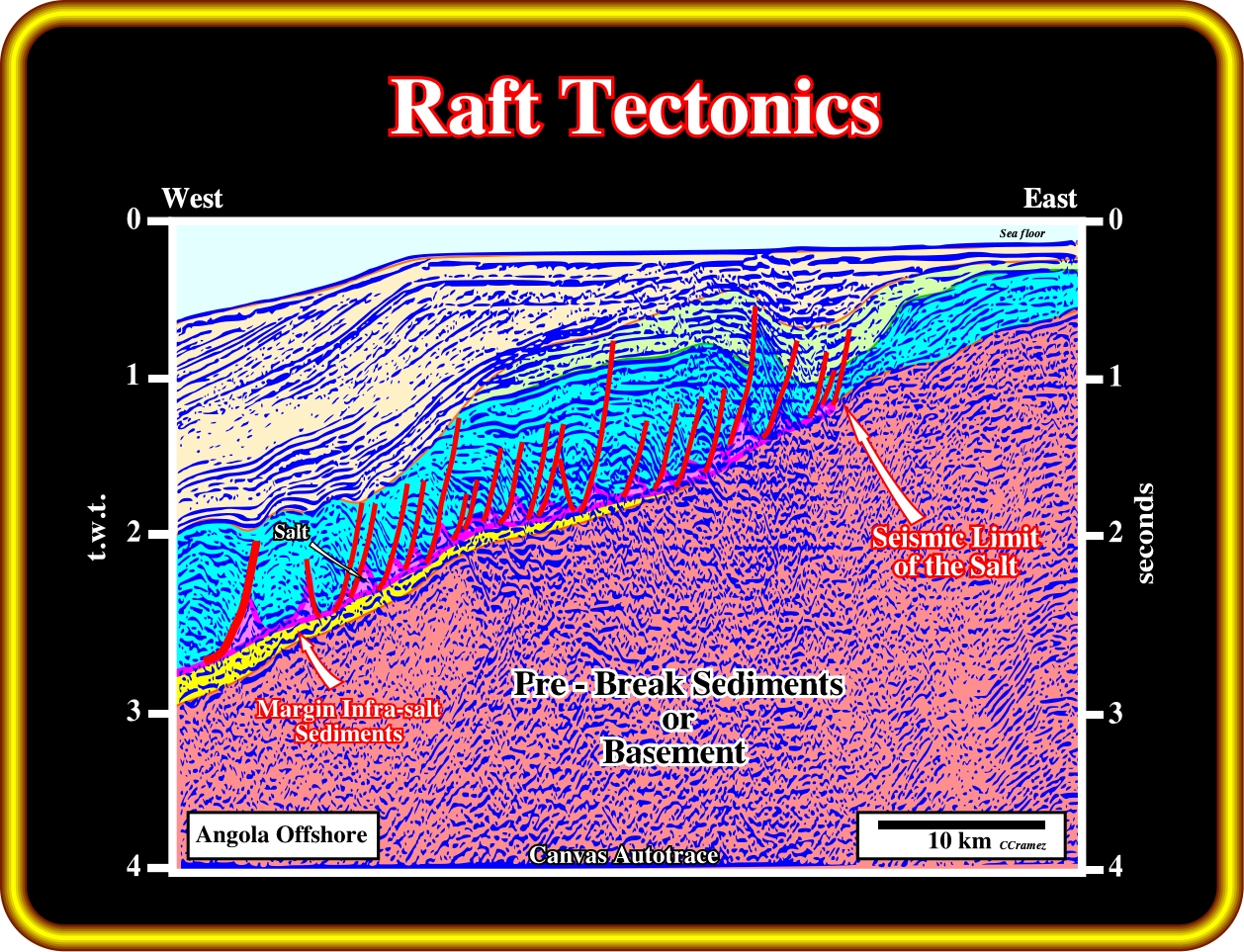
In the northern part of Kwanza offshore, southward of the Ambriz structural high, the eastward limit of the salt basin is easily located by the first major basinward growth-fault and the associated Upper Cretaceous / Tertiary depocentre. Seaward, raft tectonics, induced by a seaward extension and halokinesis, is paramount. Details of this particular tectonics are illustrated in next figures.
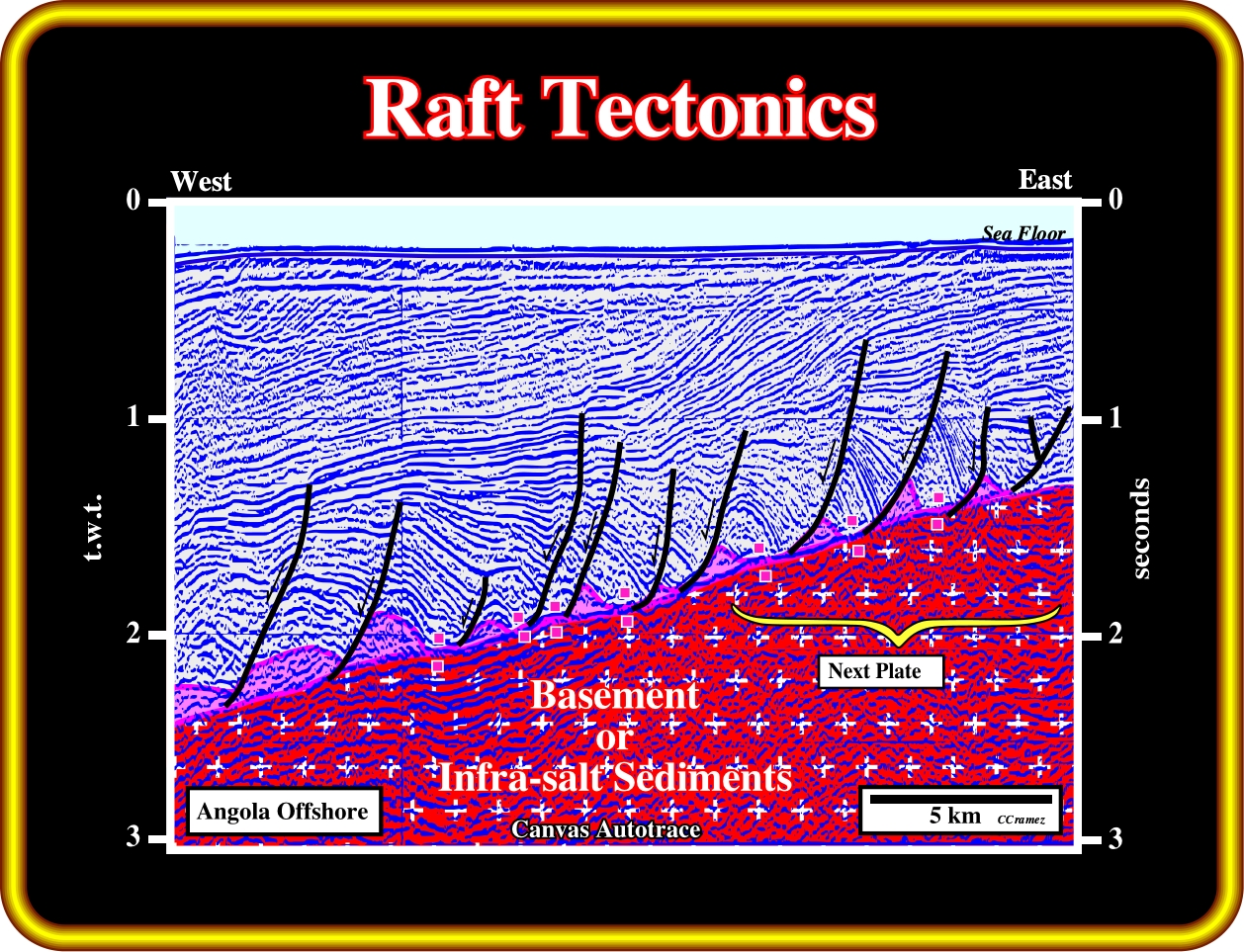
On this seismic line, above the tectonic disharmony, induced by salt flowage, raft tectonics is paramount. An isopachous sedimentary layer, which originally was overlying the salt, was broken into different blocks (rafts) by listric normal-faults with a seaward vergence. The seaward gliding of the rafts created space available for deposition of the synkinematic layers, which, by progressive gliding, developed apparent downlap surfaces. The eastern part of the line is zoomed in next plate. It shows all rafts’ details.
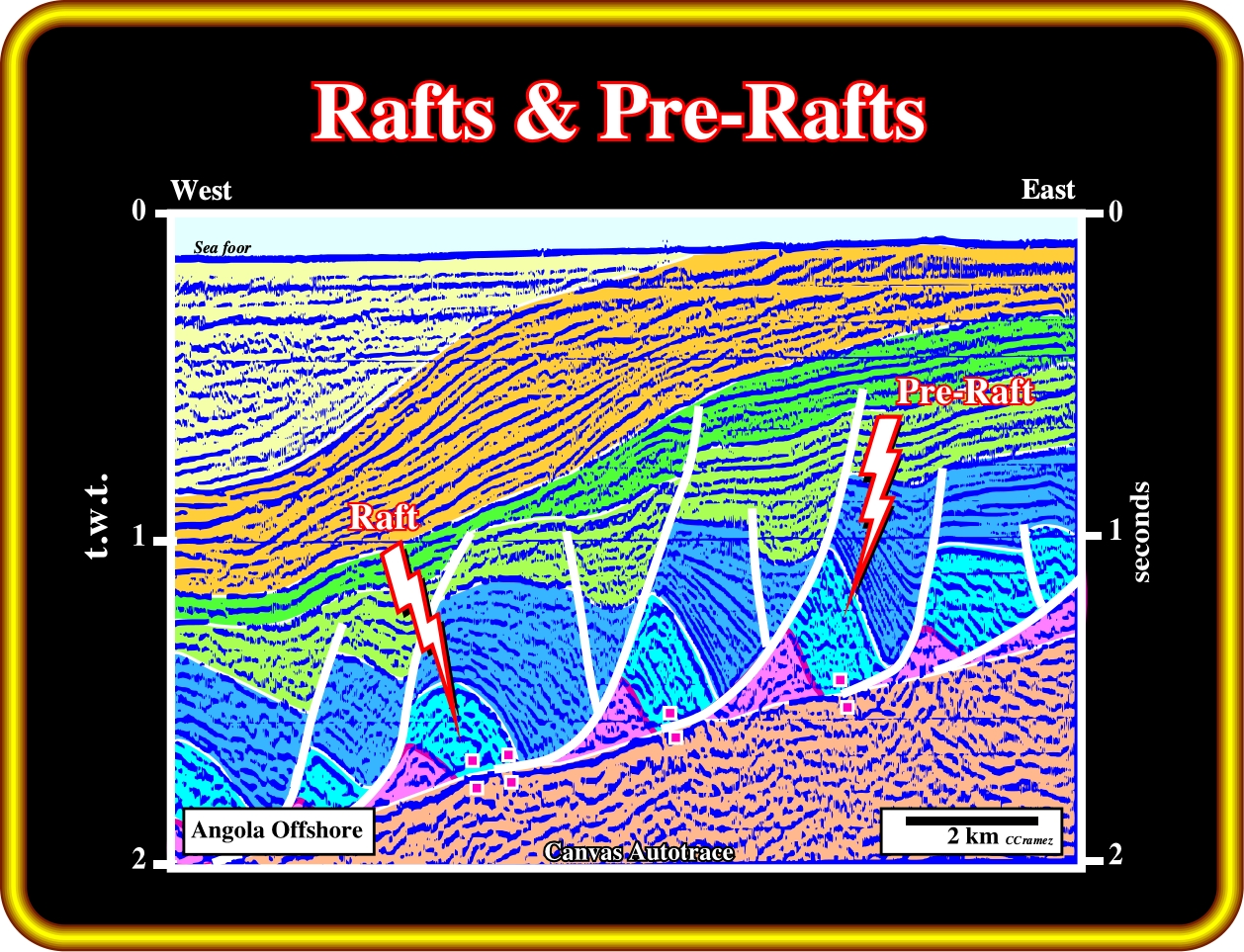
On this close-up of the previous plate, rafts and pre-rafts can be recognized. Rafts do not rest on their original up-thrown blocks. Rafts, which are not completely disconnected (without an evident salt welds between them), are often called pre-rafts.
The formation of rafts is depicted in the plate below. It can be summarized as follows:
a) An isopachous overburden overlies a thin salt (both are slightly tilted) ;
c) The salt and overburden are lengthened by normal-faults with onset of synkinematic trough-like depocenters ;
d) The internal configuration of the depocenters is generally landward divergent ;
e) The chronostratigraphic lines thicken toward the normal-faults (growth-faults) ;
f) The down-thrown blocks of prekinematic (isopachous) interval of the overburden glide down-dip, increasing the size of the synkinematic depocentre ;
g) With increasing of the fault heaves, the sedimentary lengthening reaches a point where the blocks of isopachous overburden become rafts by complete disconnection ;
h) The blocks begin to be disconnected (the hanging-walls do not rest anymore on their original footwalls) ;
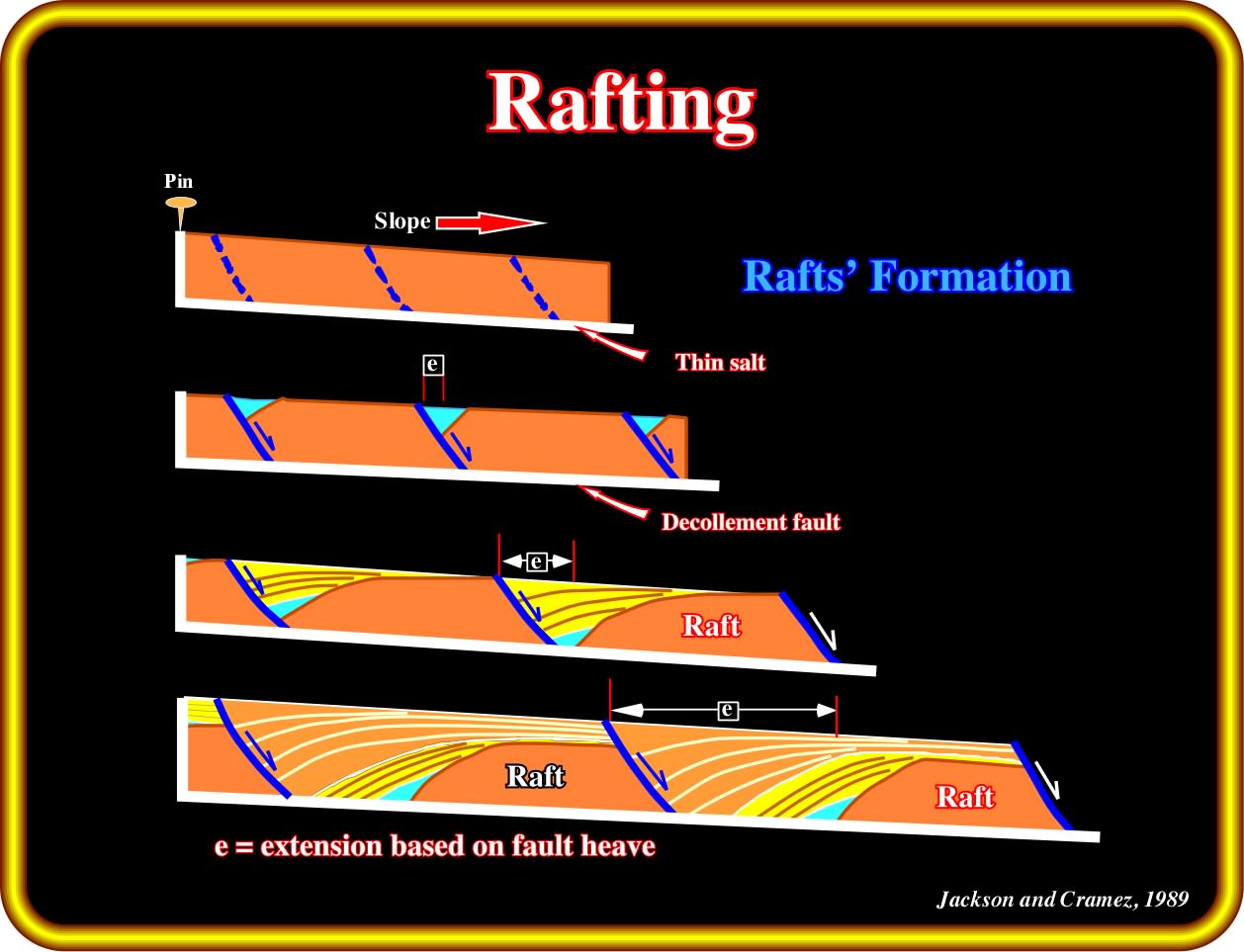
In the formation of rafts, several steps can be considered. During first step, there is overburden deposition over a relatively thin salt layer. During the second step, there is a seaward tilting of the basin. In the third step, the overburden breaks in several blocks (growth-faults) and each block glides down-dip along a décollement surface (generally a fault weld) with development of synkinematic through-like depocentre. Finally, after a certain amount of extension, each block of the overburden becomes disconnect of the original footwall as illustrated in next plate.
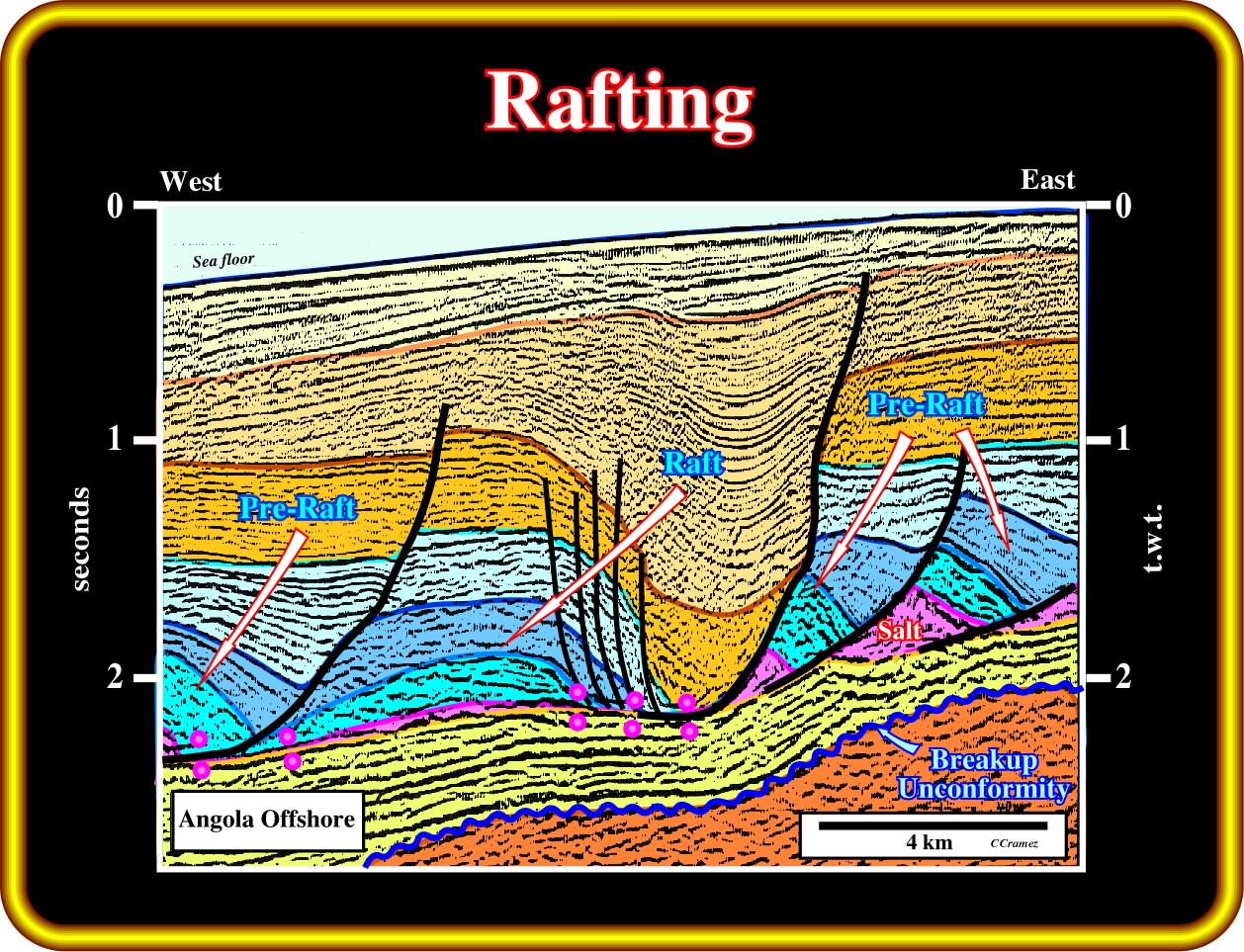
The geometry of the post breakup sub-salt strata contrasts with the geometry of the overburden. The tectonic disharmony is enhanced by apparent reflections terminations, mainly apparent downlap. The prekinematic layer is broken, but some of them still are connected, while other are disconnected. In the overburden, a relatively large trough-like depocentre separates a raft structure from pre-raft structures. The original salt layer is reduced to small salt rollers and very thin salt layer or welds.
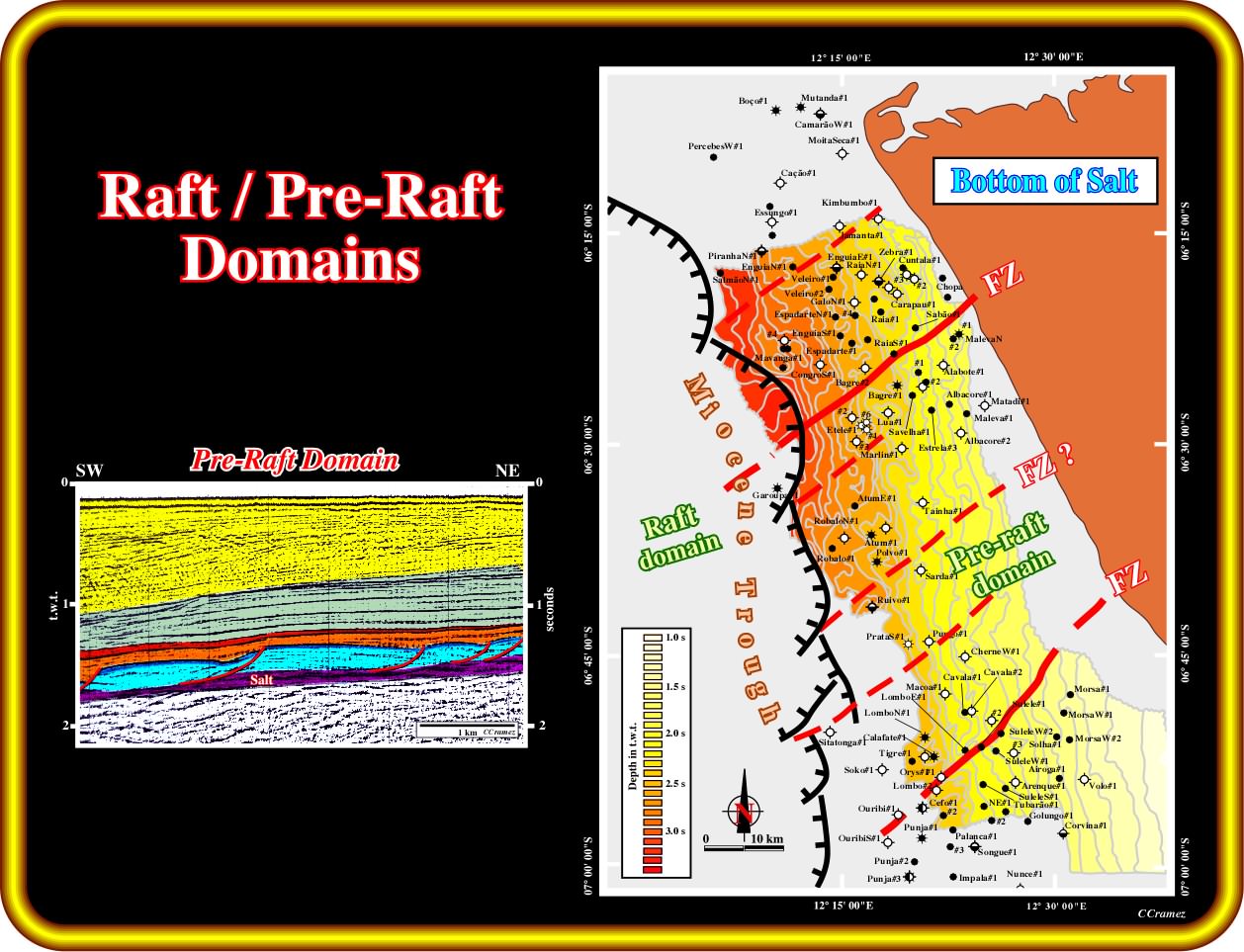
On this time contour map of the bottom of the salt, in Northern Angola offshore, a complex Tertiary faulting zone limits the pre-raft from the raft domain. The orientation of the major fracture zones (in red) and their impact on this limit is quite visible. A tentative geological interpretation of a seismic line located in the pre-raft domain is illustrated in the left part of this plate. It must be pointed out, however, that pre-rafts can be present in a raft domain, particularly in deep water.
In Angola offshore, the similarity between the pre- and post-salt structural patterns suggests that the infrastructure, i.e., the sub-salt strata, is often implicated in the deformation. In certain cases, raft tectonics seems to be related and not totally independent of the basement tectonics (basement involvement). A careful study of the top salt horizon and of the infrastructure (tilted sub-salt blocks and basement) provides valuable information regarding the Lower Cretaceous post salt structures (fault pattern and potential traps). On seismic data, the identification of the main flanks of basement tilted blocks, fossilized by the thicker sediments filling the rift-type basins, leads to a better assessment of :
(i) different shelf depositional edges, during post salt deposition ;
(ii) location of the potential traps, ;
(iii) high energy environments and
(iv) amount of gliding.
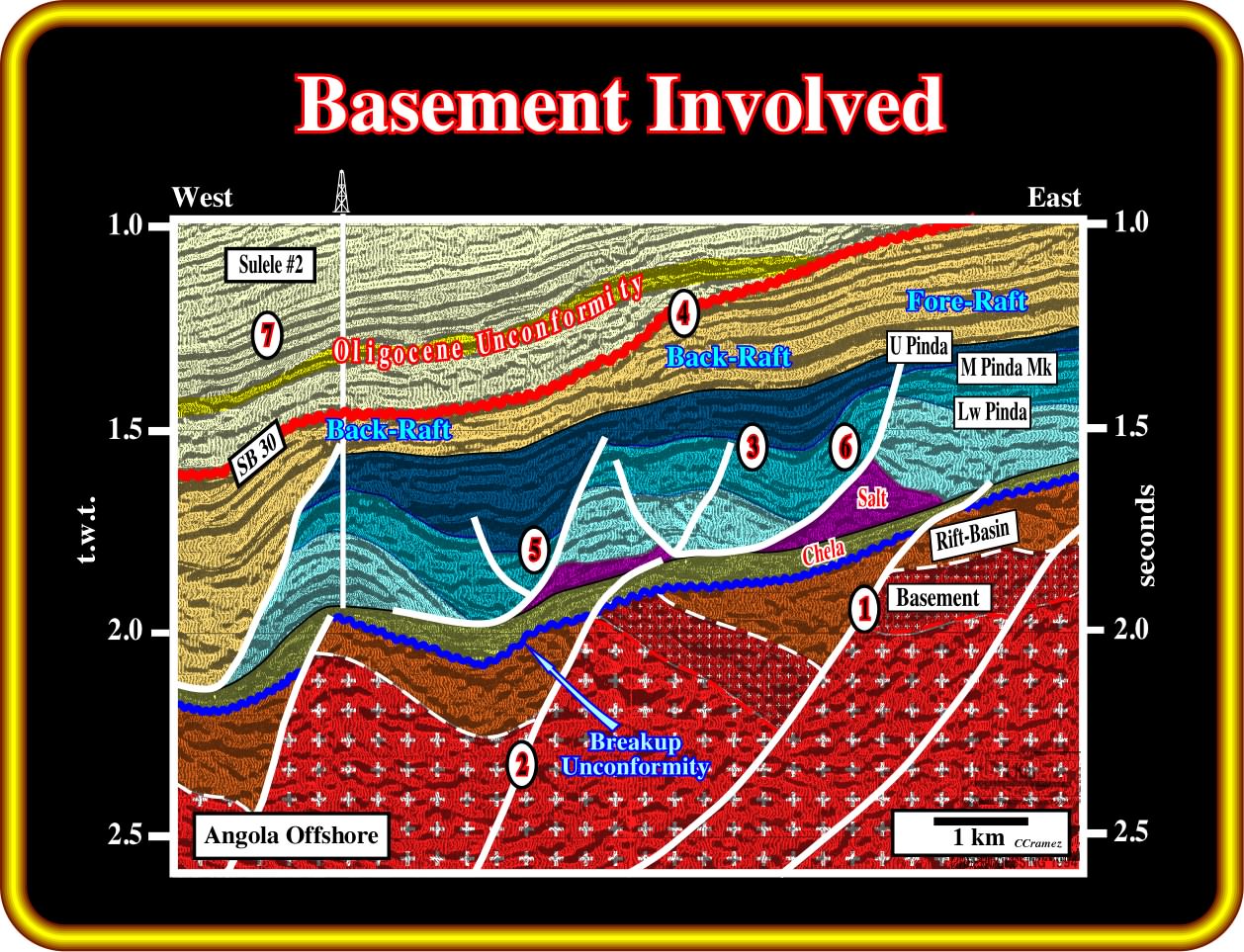
At present time, post-salt structures are shifted basinward of their original location in relation to the residual topography of the sub-salt and basement intervals. The amount of the shifting is easily recognized comparing the sub and supra-salt paleo-morphologies. The main basement fault, separating major basement blocks, is pointed out by number 1. Number 2 indicates a minor basement fault. Number 3 points out an apparent “turtle-back” structure. Number 4 points out the shelf break, at SB. 30 Ma (basement fault 2). The strong plunging of the Middle Pinda seismic marker is underline by number 5. Number 6 indicates the more likely depositional coastal break, at the Middle Pinda. Finally, number 7 underlines sand filled canyon, presumably related with at fracture zone.
The conventional classification of the post-salt structures (Pinda structures, in Angola offshore) in raft and pre-rafts was revised. Total’s geoscientists considered that the conventional correlation between the connected or disconnected character of the structures and the amount of extension proposed previously, was somehow biased. The top reservoir level was often located at different locations on the raft. On the other hand, using new or reprocessed seismic data, they reckoned much smaller displacements (less extension) of the structures, particularly in the proximal offshore areas. A new classification of the post-salt structures was proposed taking into account the geometric characteristics of the structures and their strong correlation with the residual topography of the basement (or infrastructure). Therefore, in addition to raft and pre-raft structures, described previously, two other types of structures were distinguished :
(A) Fore-rafts and
(B) Back-rafts.
(A) Fore-Rafts
These structures are deposited above the upper compartments of the major basement faults and quite close to the noses of the large tilted basement blocks (see the above plate, taking into account the translation). Some seismic examples of this type of structures are shown in next plate. They are supposed to present the highest hydrocarbon exploration potential. Additional characteristics features are:
(i) Presence of erosional surfaces ;
(ii) Steep dips ;
(iii) Large salt pillows and
(iv) Deformation at Lower Tertiary level.
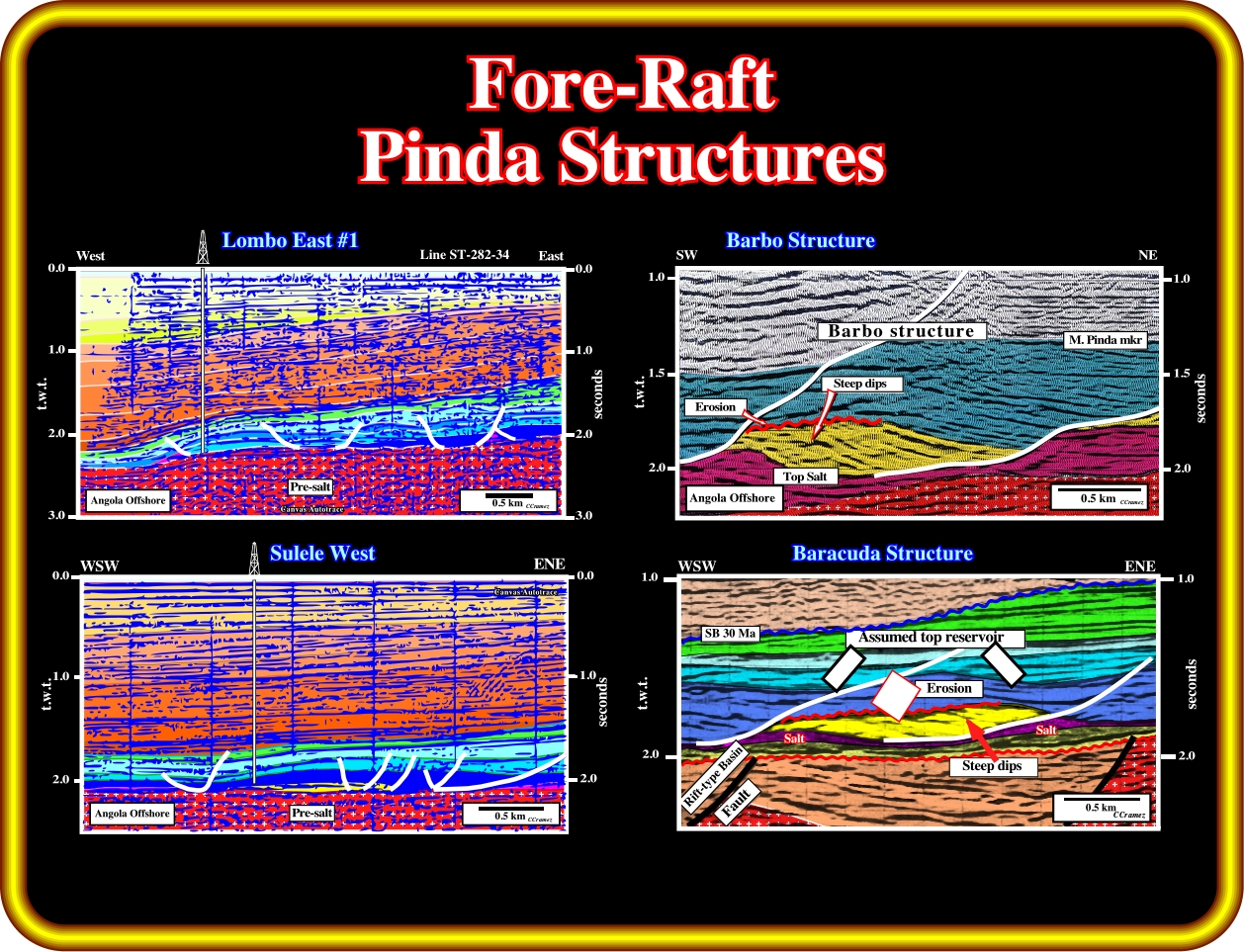
As illustrated in this plate, fore-raft structures have two main geometries: (i) An antiform geometry, as in Lombo East #1 and Sulele West or (ii) A tilted geometry, as in Barbo and Barracuda structures. The geometry depends whether the salt below the structural high had flow away or not. In other words, the antiform fore-raft geometry corresponds to a tectonic inversion induced by salt tectonics, which does not take place in the tilted geometry. Fore-rafts show generally angular unconformities at the top of the reservoir facies.
(B) Back-Rafts
Back-rafts are another type of post-salt structure. They are deposited just above the downward compartment of the major faulted blocks. Therefore, they are presumed to have the highest exploration risks (high accommodation, low energy). These risks are related to:
- The misinterpretation of the top reservoir level ;
- The possible presence of a waste zone ;
- The possible decreasing of the porosity induced whether by a large water depth or by anhydrite plugging.
A complication of this rather simple classification can be introduced by the structural pattern of the infrastructure, which often shows different structural trends. Indeed, in the offshore of South Atlantic margins, and particular in offshore Angola, the presence and the reactivation of the old fracture zones of the basement, which strike more or less NE-SW, enhances the complexity of the structural pattern. However, fracture zones are easily recognized on the seismic data. They generally displace the bottom of the salt layer (or weld) and they can create compressional structures in the overburden, when reactivated.
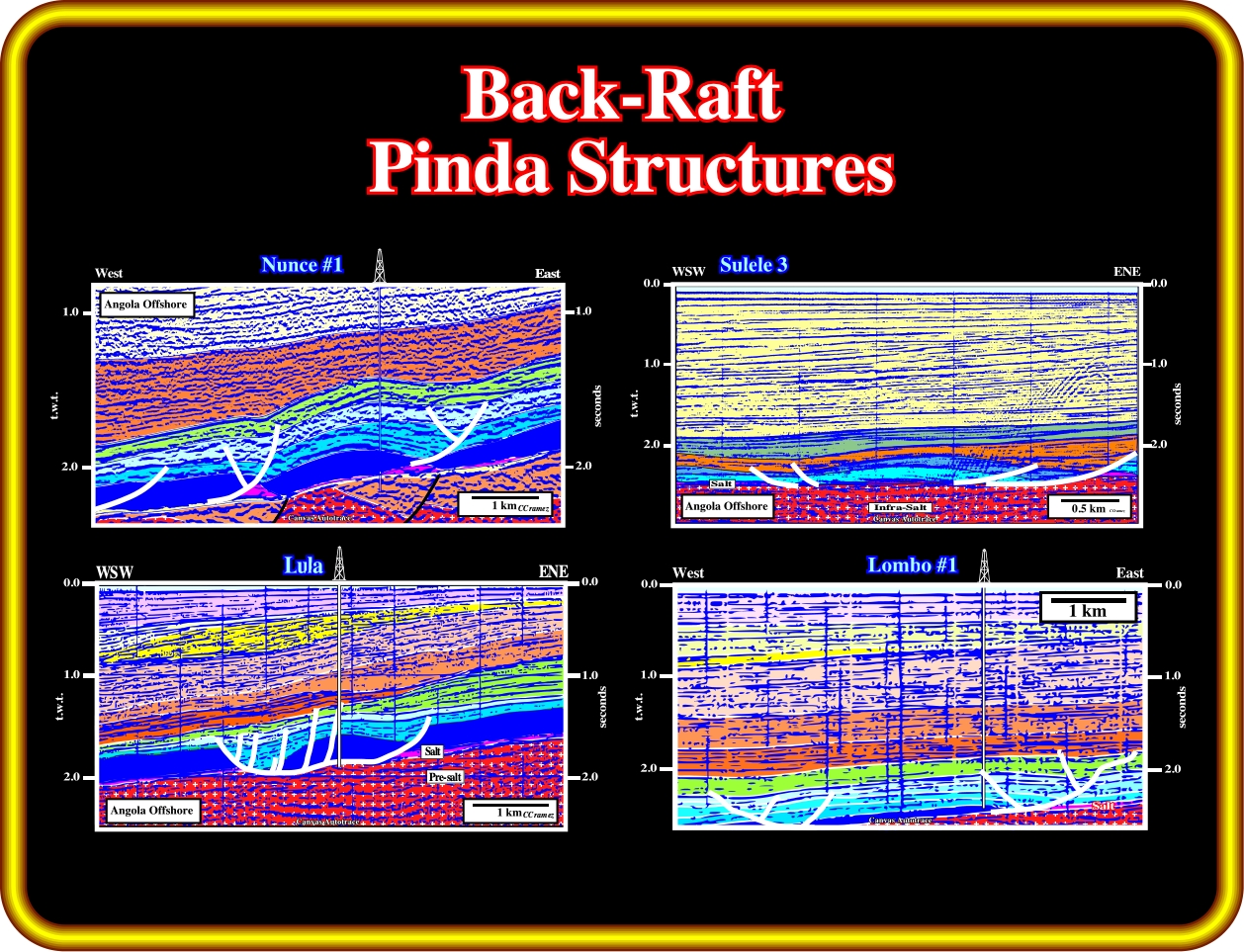
All the examples of back-raft illustrated above have an antiform geometry created by salt withdrawal. The internal configuration of the different Pinda intervals is divergent landward in association with an apparent downlap seismic surface (rotated onlaps induced by compensatory subsidence). Reservoir facies are possible, but they are restricted to the seaward most part of the structures. The preponderant facies of these structures has sealing characteristics.
In the salt basins of the South Atlantic margins, where raft tectonics is usually present, the location of raft and pre-raft structure is not aleatoric. Indeed, as illustrated below, a pre-raft domain is located landward of the Atlantic hinge zone, while the raft realm is located seaward, where the tilt of the margin is much higher.
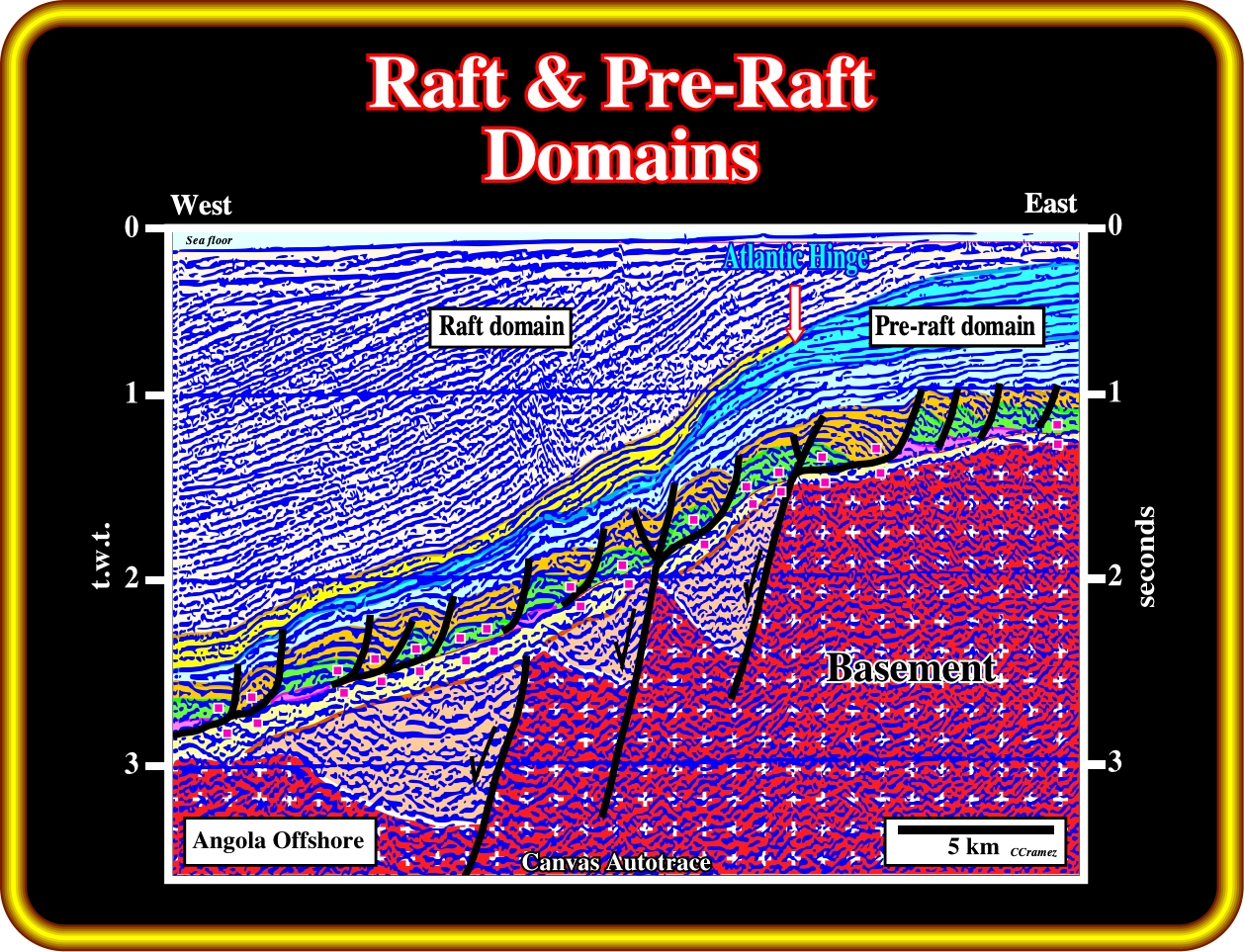
The toplaps on the sea floor indicate uplift and erosion. Uplift took place during Late Tertiary enhancing the structural behaviour. The Atlantic hinge is easily located. The break-up unconformity shows a sharp change in dip, as well as the tectonic disharmony. The pre-rafts are located landward of the Atlantic hinge. Seaward, the rafts are predominant.
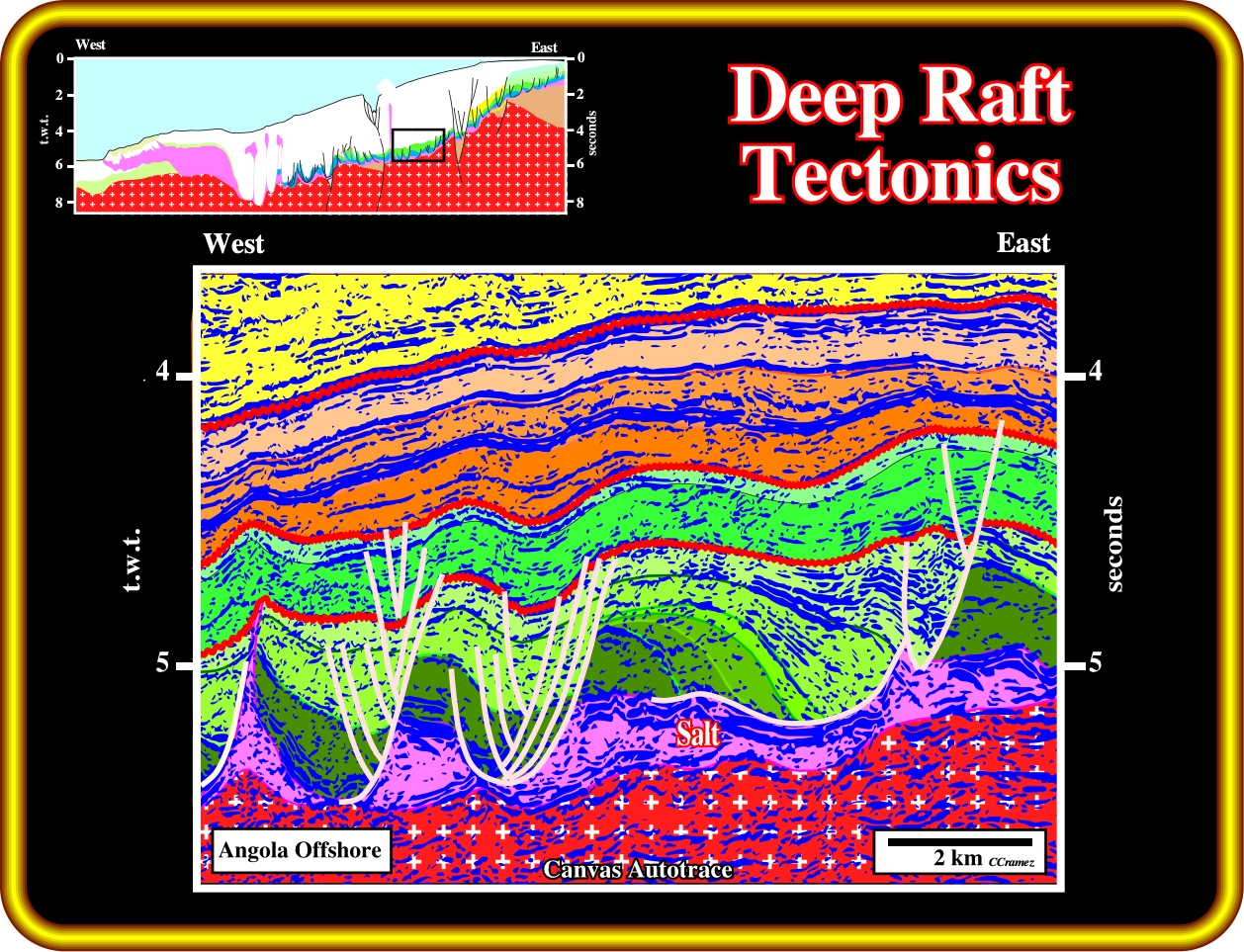
In deep water, seaward of the limit between the pre-raft and raft domain (see location of the figure on the regional line, on the left upper corner), pre-rafts are recognized with the raft domain. A significant back-raft structure can be seen in the middle of the line. Actually, as it will be shown later, in Angola offshore, the presence of Mesozoic pre-raft domains between Tertiary rafts can be explained by rafting episodes of different ages.
The sketch below (next plate) summarizes the more likely mechanism for the formation of pre-rafts and rafts. Several tectonic-sedimentary phases can be considered:
a) Along a slightly dipping margin, the salt layer flows, generally down-dip, inducing the breaking of prekinematic overburden (when present) creating at the same time an shelf increasing accommodation ;
b) The relative sea level rise induced by the compensatory subsidence (generated by salt flowage) increases the space available for the sediments and deposition takes place ;
c) Asymmetric synkinematic depocenters thickening toward the growth fault planes, which extend seaward the overburden ;
d) Increasing of thermal subsidence reactivates pre-existent faults (pre-breakup and rifting faults) creating sharp dip changes on the bottom of the salt layer ; it is the onset of the Atlantic hinge ;
e) Seaward of the dip change, extension induced rafting ; the isopachous faulted blocks are disconnected, while landward, they stay more or less connected (there is no welding) ;
f) The subsidence increases the extension (large depocenters, lying on very thin salt or directly above the sub-salt strata, are formed seaward of the Atlantic hinge) ;
g) Landward of the Atlantic hinge, the extension is almost nil ; the accommodation is created mainly by halokinesis (salt flowage), but, generally, it is insufficient to change the pre-raft geometry.
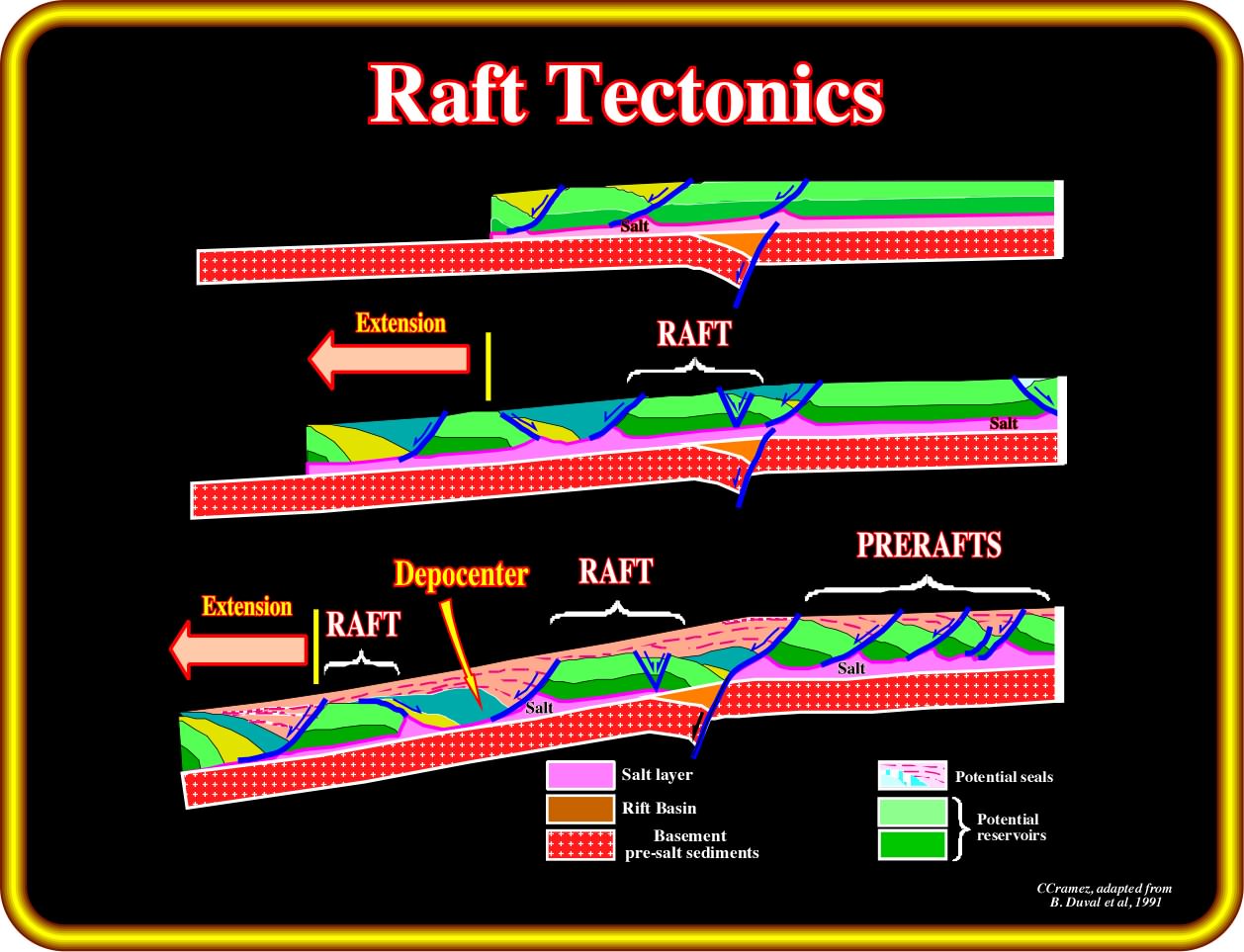
This geological sketch summarizes the main steps of the pre-rafts and rafts formation, which cannot be explained just by halokinesis. At the scale of the basin, extension is absolutely indispensable for the formation of the rafts.
During the evolution of the South Atlantic margins, several rafting phases took place. In Angola offshore, as illustrated in next plate, two main rafting phases are likely. In the first phase, there was formation of pre-rafts and 1st order rafts, while 2nd order rafts were formed in a second rafting phase. Rafts can glide down-dip together inducing the formation of huge depocenters lying directly upon the sub-salt strata or infrastructure.
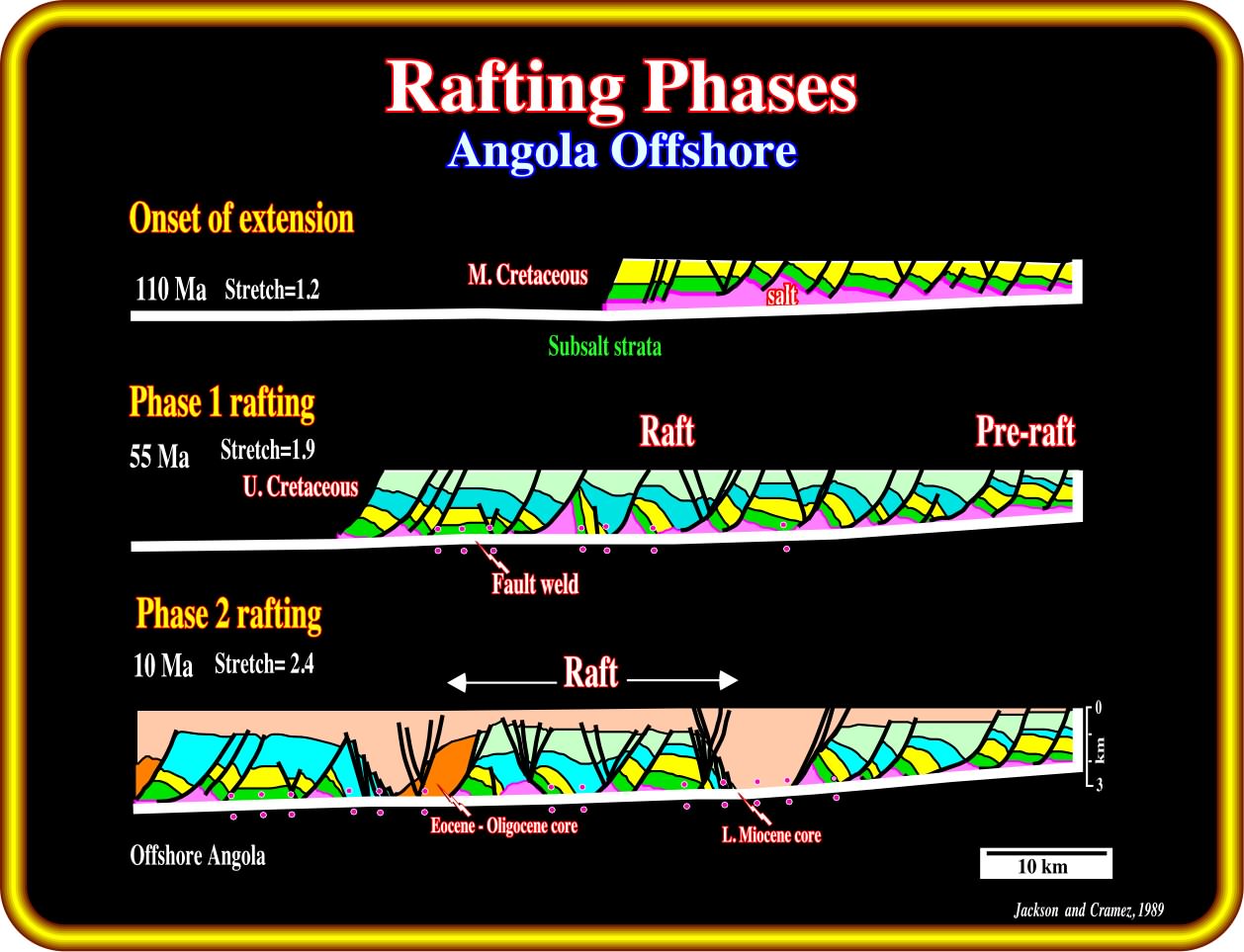
In this model, it is easy to understand the formation of 2nd order rafts. They are bounded by huge trough-like Tertiary depocenters, in which Lower Tertiary sediments are often found. In the beginning of the extension, around 110 Ma, the stretching (ß) was around 1.2 . Between the onset of the extension and phase 1 (roughly 55 Ma), the stretching (ß) was more or less 1.9 . Finally, between phase 1 and phase 2 (around 10 Ma) the amount of stretching was roughly 2.4 .

On this geological tentative interpretation, seaward of the Atlantic hinge zone, 2nd order rafts are recognized. They are limited by Tertiary trough-like depocenters (in light yellow). Between each Tertiary depocentre, Mesozoic 2nd order rafts can be isolated. Mesozoic pre-rafts structures are recognized within the 2nd order rafts located near the western end of the line. Notice, that the Atlantic hinge (near the salt diapirs) seems to be related to the reactivation of pre-existent faults, probably at fracture zones.
Rafting tectonics needs space. Theoretically, there are two basic ways to create space in order to allow rafting. They can labelled:
(i) Down-dip Thrust Fold Belt and
(ii) Displacement of Allochthonous Salt,
as illustrated next.
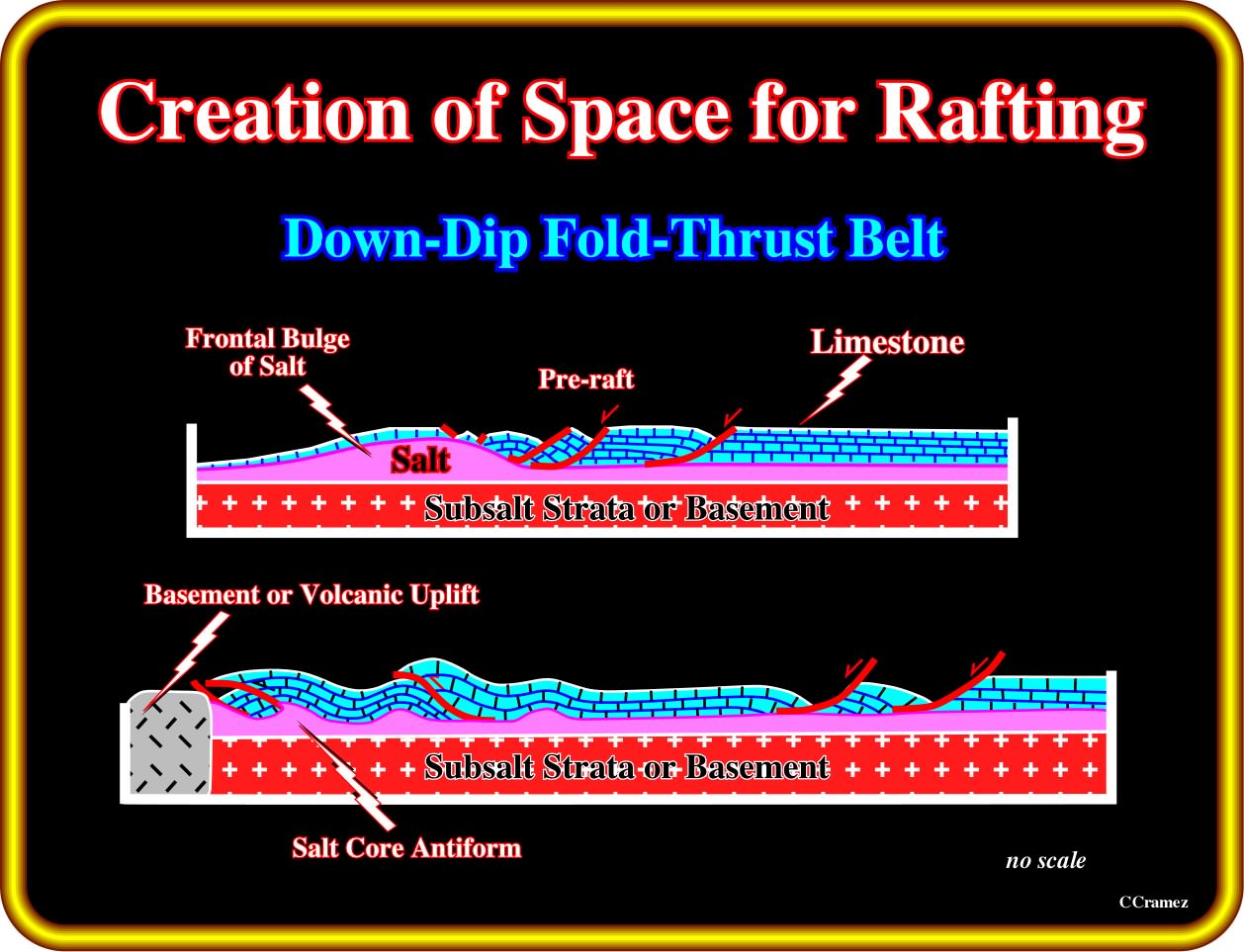
In this hypothesis, the fold-thrust belts, which are often recognized on the distal areas of divergent margins when salt layers are inter-bedded, can be explained as a counterpart of the up-dip extension. The up-dip lengthening is compensated by a down-dip by a local shortening.
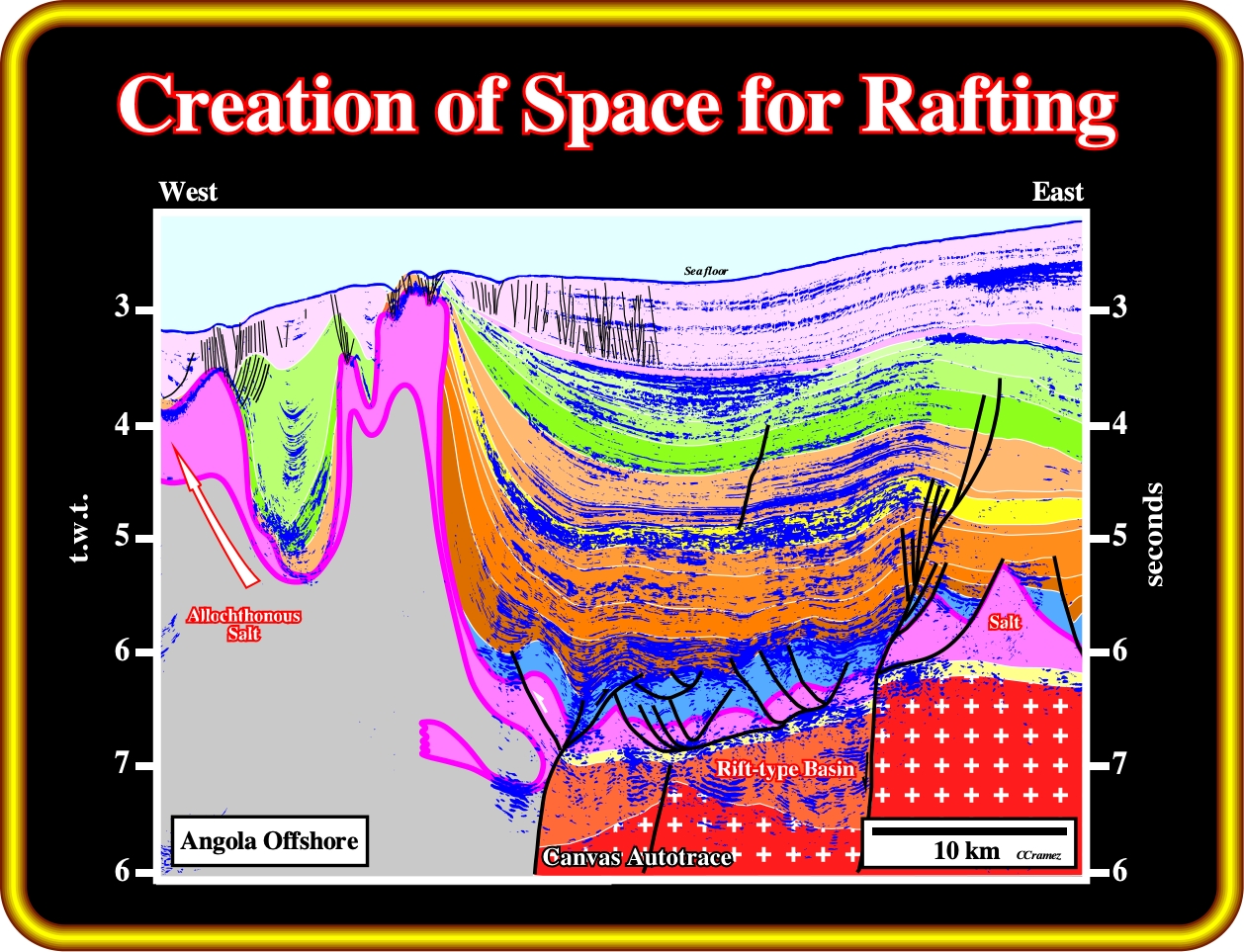
Taking into account that, in the Upper Tertiary, the overburden was locally shortened following the reactivation an old fracture zone. This geological tentative interpretation shows how the emplacement of an allochthonous salt structure creates space for rafting up-dip.
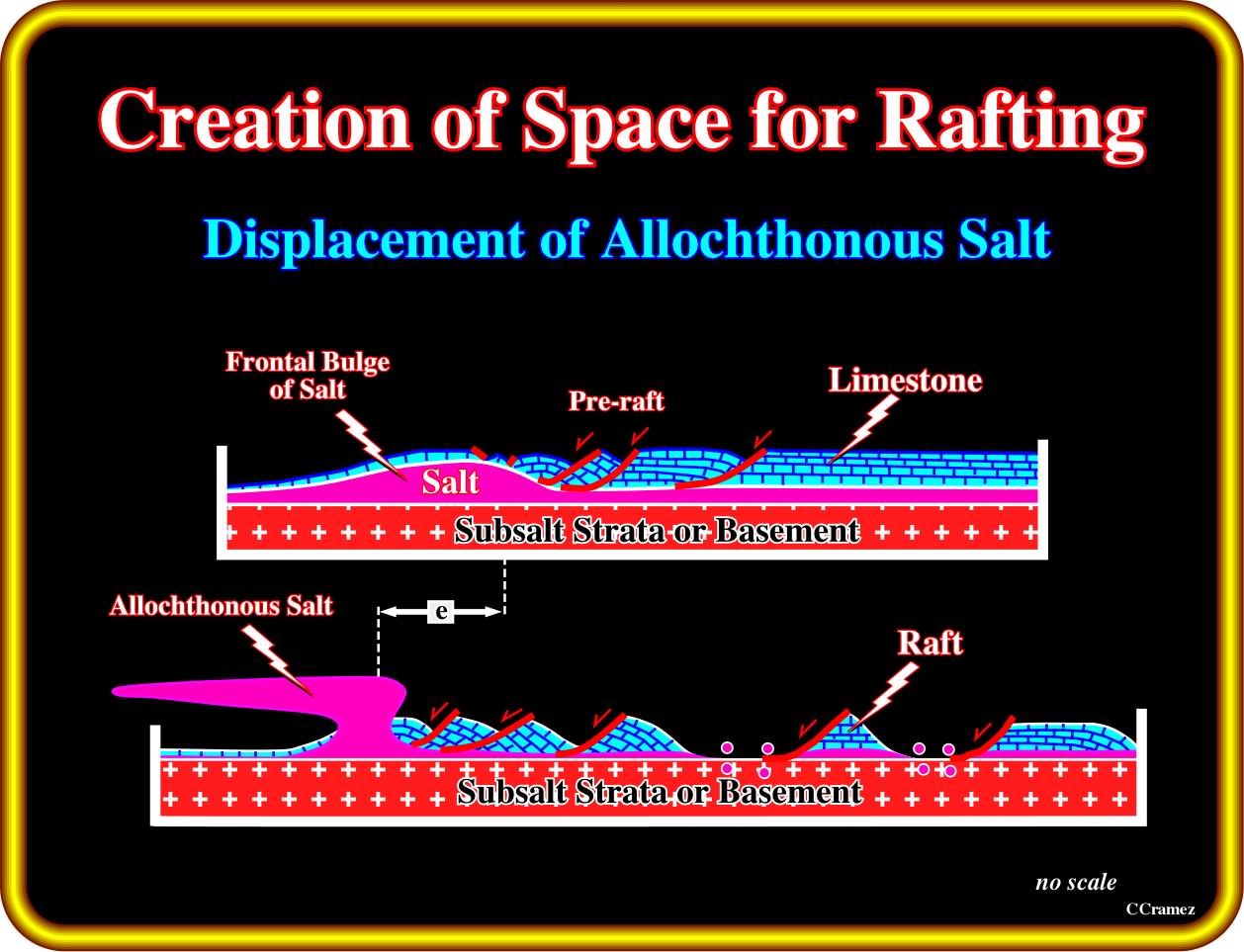
In this geological mechanism, the space, required for rafting, is created by the emplacement of allochthonous salt structures. This mechanism is similar to the compensatory subsidence induced by salt flowage.
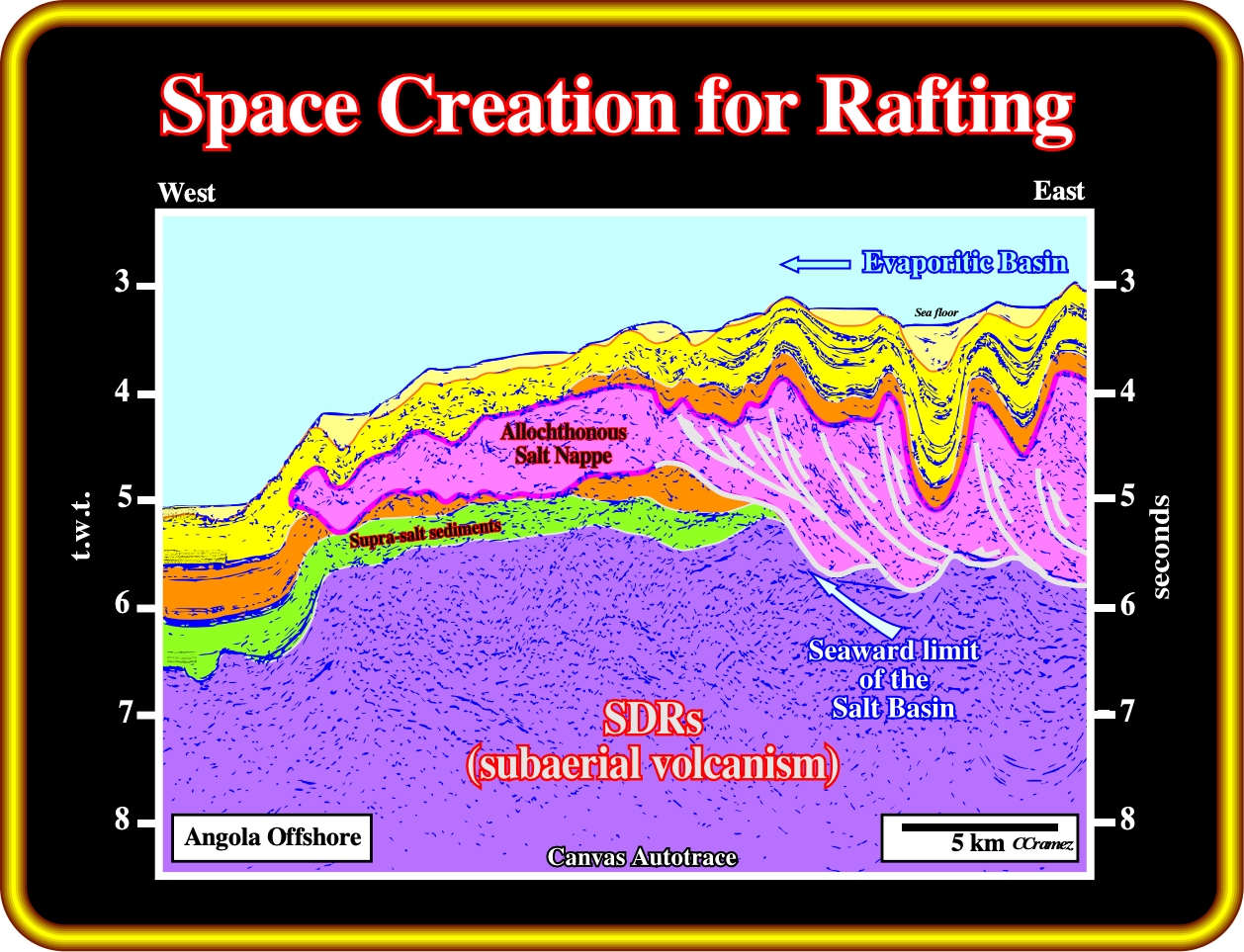
Here, the space required for rafting, in the up-dip area of the margin, was created by shortening and emplacement of allochthonous salt in the western end of the salt basin. A simple manual depth-conversion of this seismic line (just doubling the thickness of the salt) strongly suggests step of 2-3 km in the sub-salt rocks (looking eastward). This step has been interpreted as the western limit of the Aptian salt basin in the offshore Angola. Westward of this step, the salt is allochthonous. It was also slightly shortened.
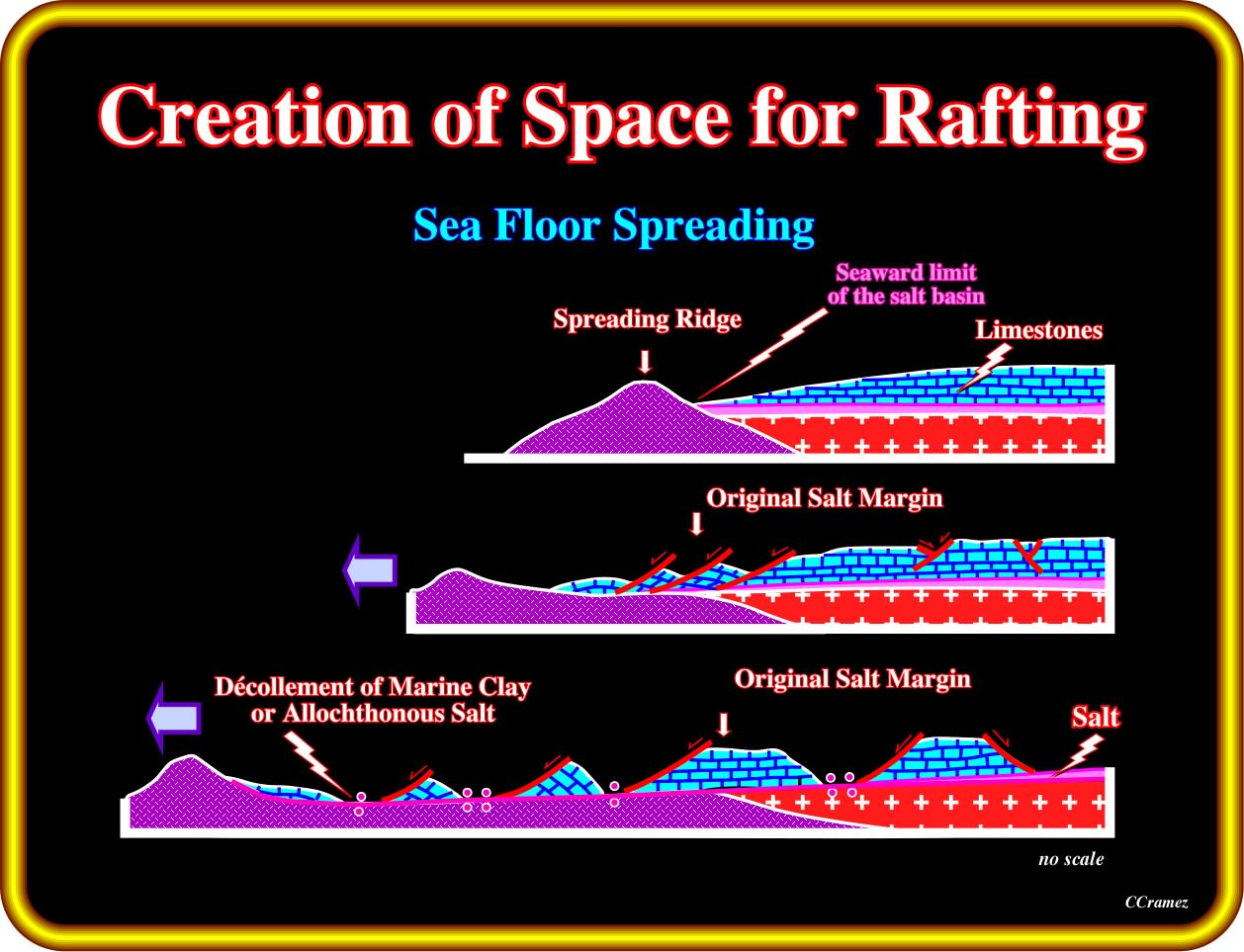
Another mechanism, which can create space for rafting, is the oceanic expansion. Since the breakup of the lithosphere took place, at the end of the rifting phase, volcanic crust is emplaced. At the beginning, the volcanic crust was mainly composed by lava flows and the margin sediments were deposited on each side of the spreading centres. Physically, the emplacement of new volcanic crust (subaerial or oceanic) induced a potential void in the margins allowing the cover (salt and overburden) to extend by rafting.

This cross-section performed with well results and controlled by 1960’s vintage seismic lines, illustrates what Total’s geoscientists label, in the 60's, “Tectonique en Radeaux”, in Angola offshore. As illustrated, some of these structures can be explained by opposite hypotheses. The main problem is explaining the creation of space for rafting. Here, halokinesis is probably the preponderant mechanism. However, it cannot explain all structures, since translation of the overburden above a décollement surface (top salt or fault weld) is quite evident as illustrated in next plate.
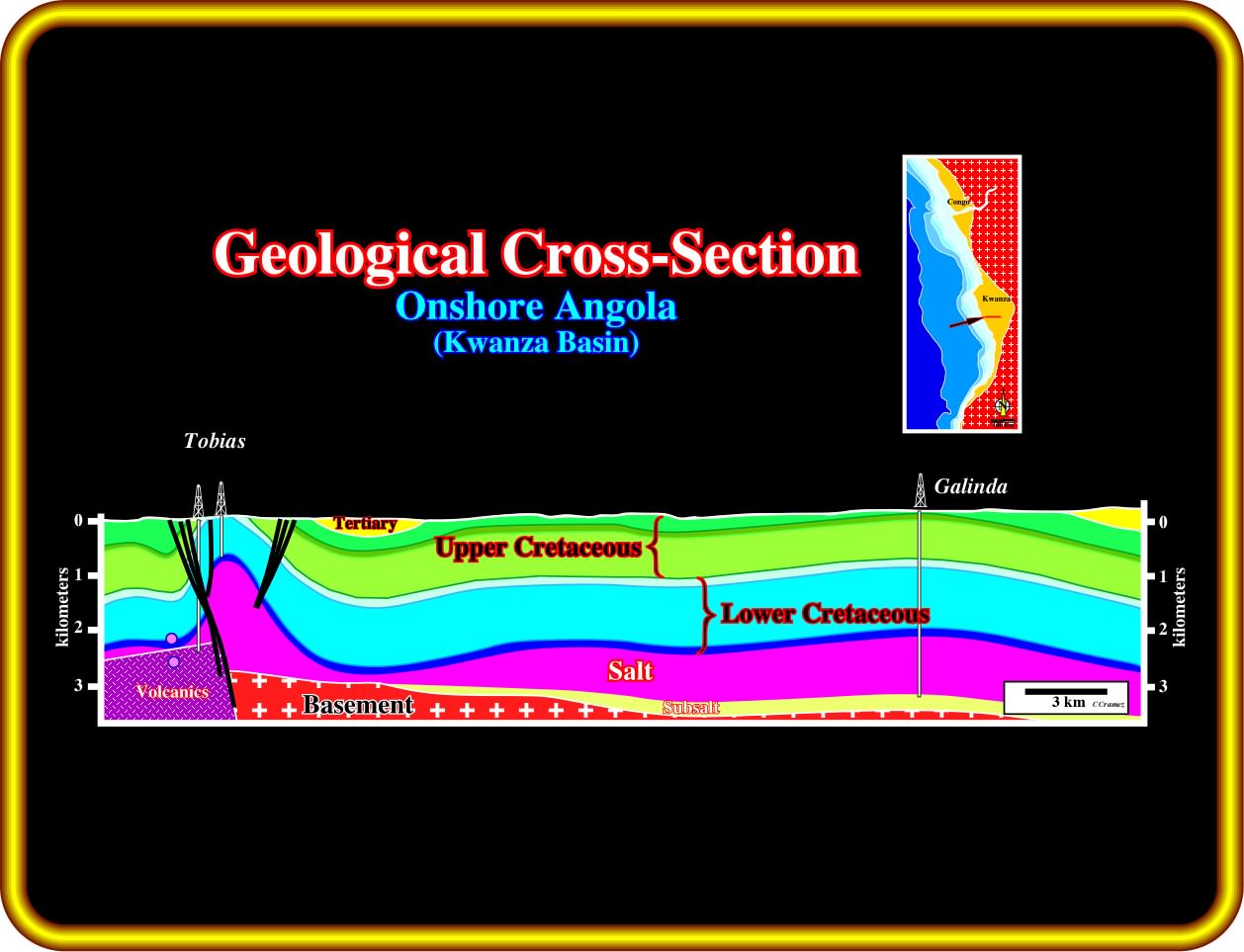
This cross-section was proposed in the 60’s by Petrangol’s geoscientists. It illustrates how a local compression gives space, up-dip, to rafting. Also, it corroborates the translation of the overburden over the top salt, which works as a décollement surface. The volcanic high buttresses the seaward translation of the overburden creating a local compressional regime, which is responsible for the Tobias anticline (not Tobias antiform). When translation finds a depression, or a trough, extensional structures are developed in the synkinematic layer of the overburden.
Exercise 1:
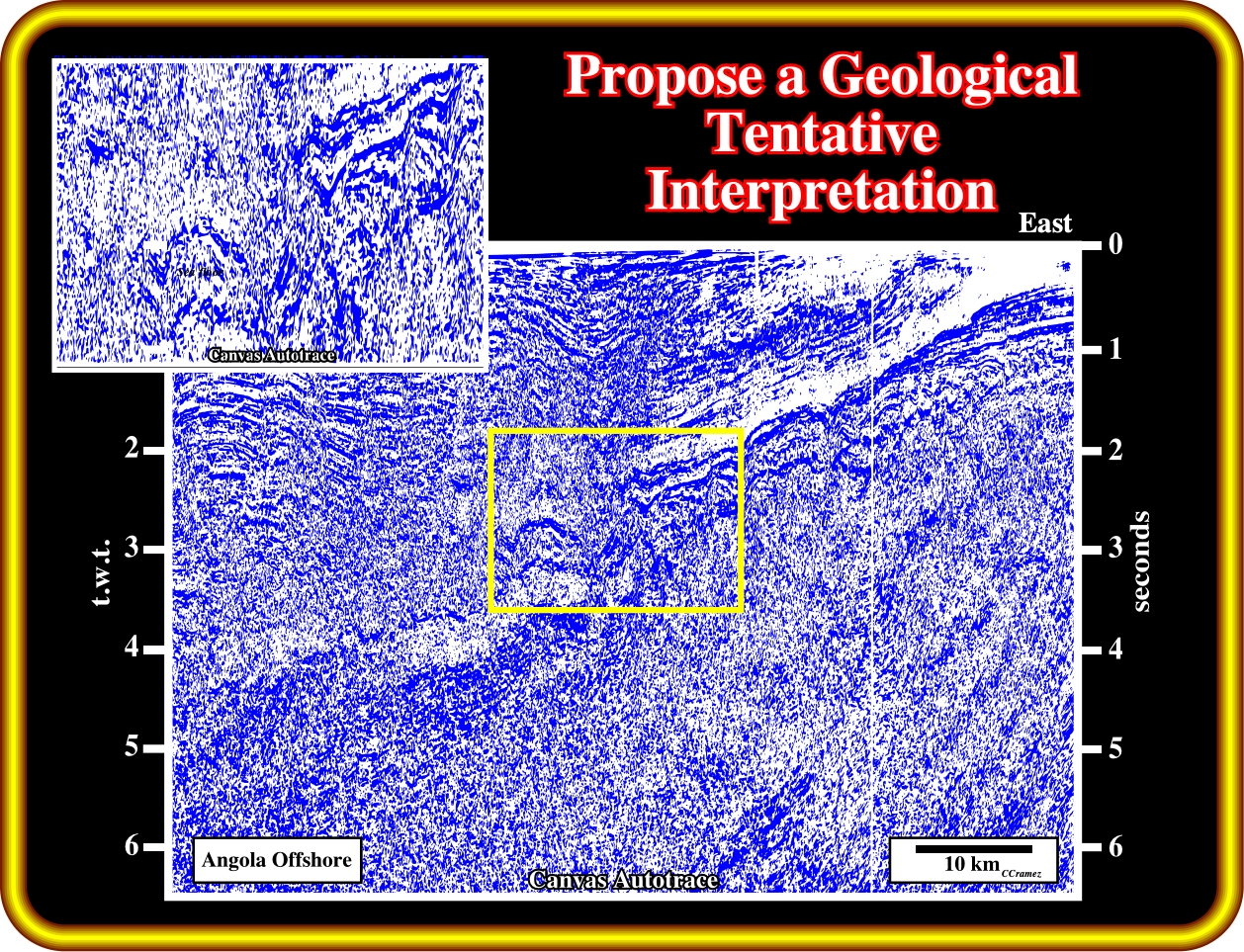
After proposing your tentative interpretation (take into account the close-up), answer the following questions :
(i) In what salt context is this line located (inner Kwanza basin, costal arch or outer Kwanza basin) ?
(ii) Where is located the Atlantic hinge zone ?
(iii) How many rafting domains can you recognize on this line ?
(iv) Explain the toplap geometrical relationships at the bottom of the sea ?
(v) How to you limit the transgressive phase of the post-Pangea continental encroachment cycle ?
Exercise 2:
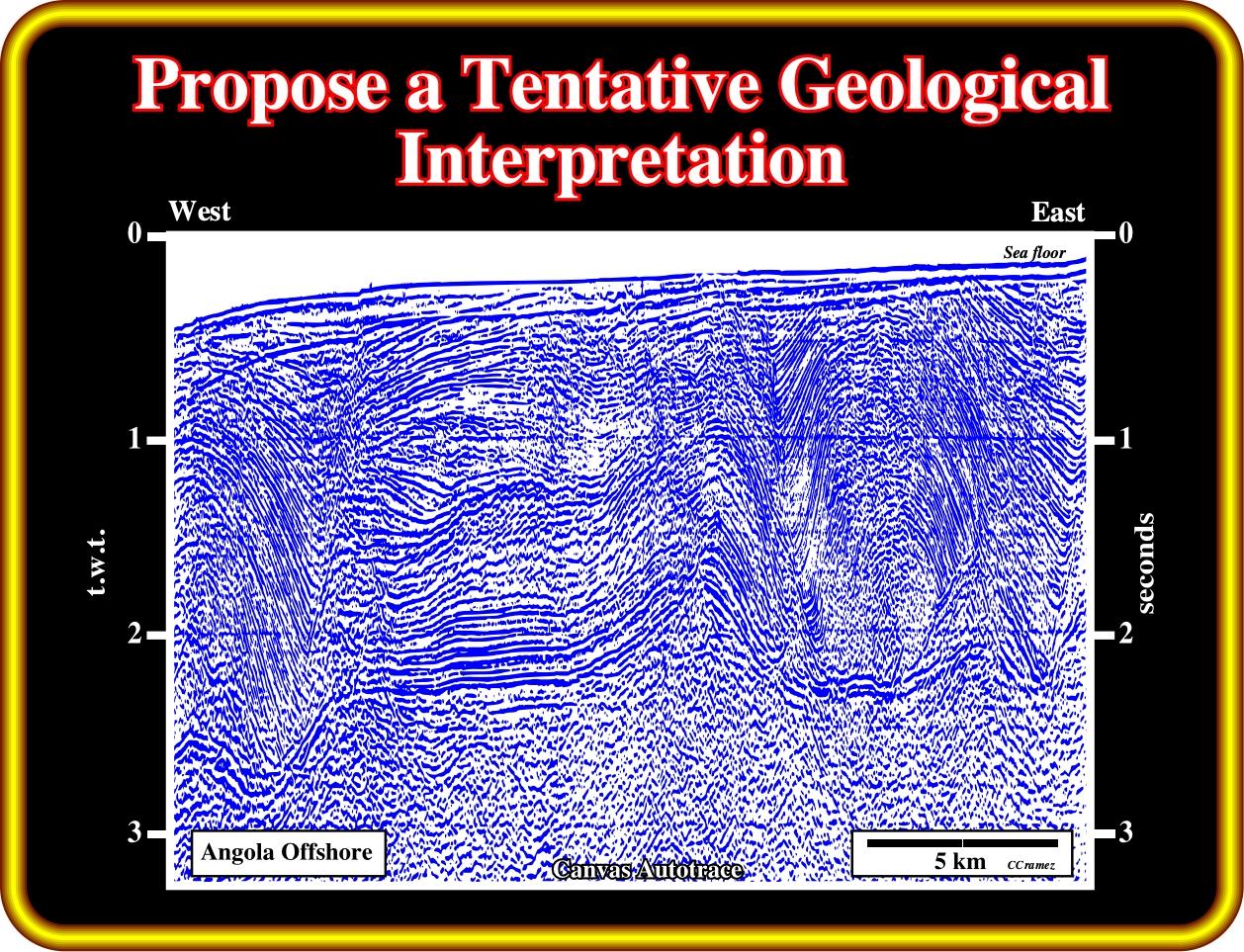
In your tentative interpretation you must pick the bottom and top of the salt, as well as, the associated salt welds. Explain the geometry of the tectonic disharmony induced by the salt. What is the hierarch of the raft visible in the central part of the line ? In what salt context is located this line ? Propose an explanation for the young depocenters. Are these depocentre structural traps or traps by juxtaposition. Justify your answer. How the space was created to develop the depocenters ?
Exercise 3:
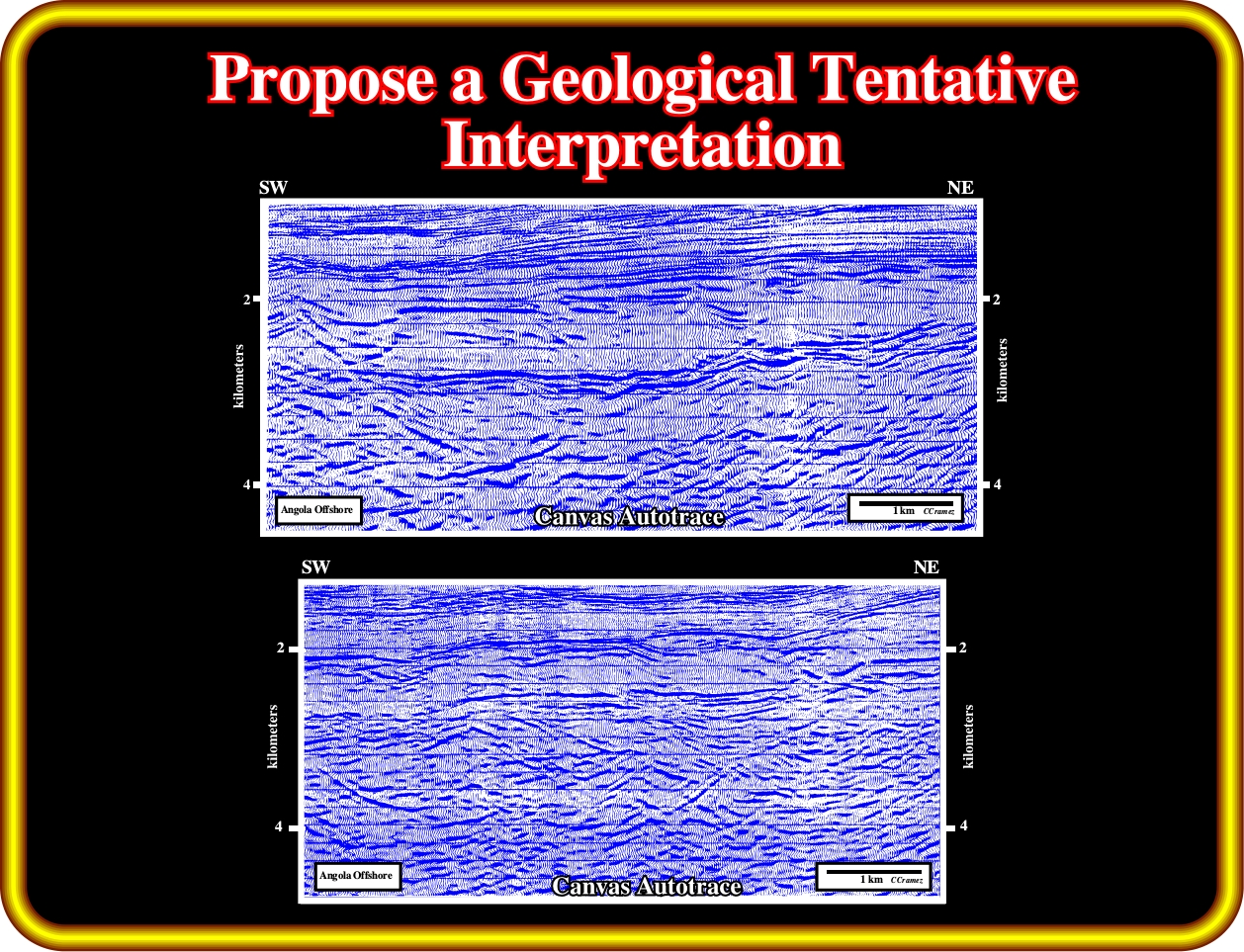
After proposing a tentative interpretation answer the following questions :
In what line are visible fore-rafts ?
Do you recognize back-rafts ?
Justify you answers.
Exercise 4:
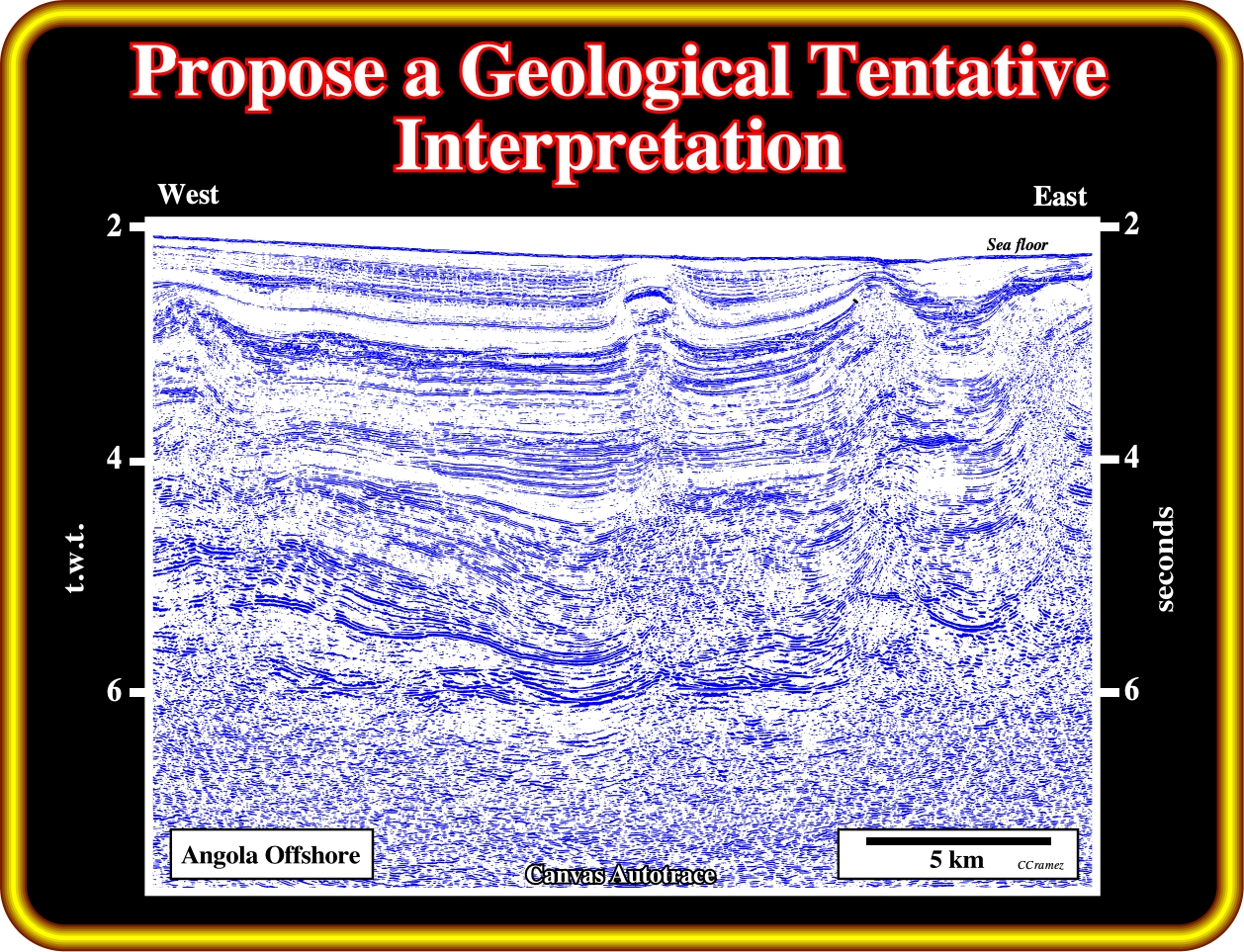
On you tentative interpretation you must recognize :
(i) An autochthonous salt layer.
(ii) An allochthonous salt layer.
(iii) A step at the bottom of the salt.
(iv) A major fracture zone.
(v) Primary and secondary salt welds.
(vi) A translation onlap surface.
to continue press
next